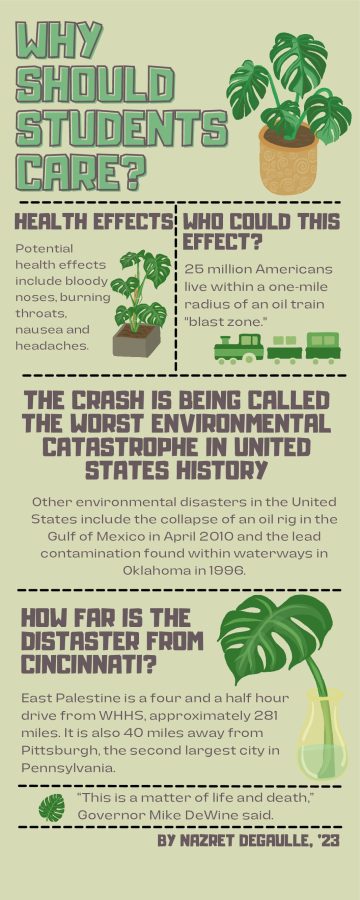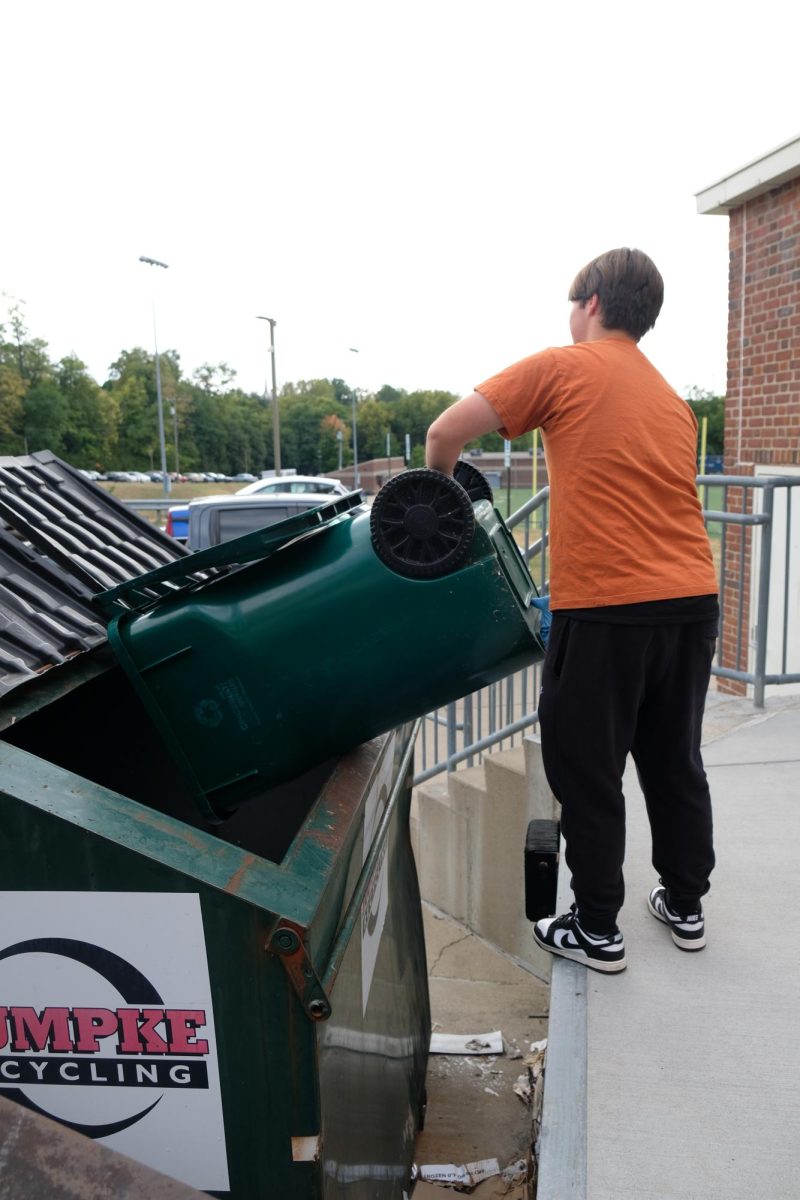Trouble on the train tracks
Although many may not initially realize it, the Ohio trail derailment has impacts on students’ lives.
March 7, 2023
A train owned by Norfolk Southern carrying about 20 cars worth of hazardous chemicals derailed in East Palestine, Ohio on Feb. 3.
Due to the concern of an uncontrolled explosion, the area was evacuated and five cars of vinyl chloride were burned. The chemicals combusted into a massive flume of smoke over the town of East Palestine. These chemicals were then released into the air and into waterways that fuel the Ohio River.
The 150-car train carried chemicals such as vinyl chloride, butyl acrylate, ethylene glycol monobutyl, and ethylhexyl acrylate. But because of Federal Law, it was not deemed to be a high hazard and thus the railway operator company was not required to inform the state of Ohio as they passed through.
The main focus of cleanup are the volatile chemicals that are found in household cleaners, but some of the semi-volatile chemicals released do not disperse as easily. They cling to the soil and other larger objects. So far, the clean-up crew has removed 500 metric yards of soil from the wreckage to cleanse the environment of as many of the toxic chemicals as possible.
According to CNN, the chemical spill took a severe toll on local aquatic life and about 3,500 fish, ranging across 12 species, died from the contaminated water washing down streams and rivers. These chemicals have been found in the Ohio River, but due to the river’s size and current, these chemicals are not considered to be harmful, as they are extremely diluted.
On Feb. 15, Governor Mike DeWine announced that “New water testing results have been returned to the Ohio EPA. These results show no detection of contaminants in raw water from the five wells that feed into East Palestine’s municipal water system.”
This has helped to quell Ohio citizens’ concerns about the Ohio River being contaminated.
Melissa Riggs, environmental science teacher, spoke on Norfolk Southern’s responsibility for this crash.
“I think they’re completely responsible for it. I mean, they’re transporting chemicals through people’s towns where they live… and where children go to school. If they aren’t willing to properly insure the transportation of those chemicals, then they shouldn’t be allowed to transport them.” Riggs said.
Norfolk Southern has taken little to no responsibility for the derailment and the dangers these chemicals pose to residents. As of Feb. 21, the United States Environmental Protection Agency has ordered Norfolk Southern to fund and conduct all clean-up actions resulting in their train’s derailment.
One of the most concerning chemicals, vinyl chloride, is a carcinogenic that becomes a gas at room temperature and is then easily dispersed. There have been claims from residents of their pets dying in the wake of the vinyl chloride plume.
“I think there is the possibility that yes, some domestic animals probably in the very beginning did get exposed to a large width [of chemicals] and it killed them,” Riggs said in response to these claims.
She explained that the full extent of the chemicals’ impact on the environment will likely remain unknown for another year or two, but its effects on humans may be felt for generations.
It comes down to how much exposure of these carcinogenic chemicals are needed to cause cancer.
“If we drink that water once, are we going to be fine? Or is that like a one time and done you’re now got that chemical in your body. And you can’t get rid of it. And so then it sits in your body like PFOSs and PFOAs. We all have that in our bloodstream because of exposure from our parents and our grandparents,” Riggs said.
PFASs, such as PFOSs and PFOAs, are chemical substances that are used to create fluoropolymer coatings that are resistant to heat, oil, water, and grease. Such products range from clothes and furniture to insulation of electric wires. The CDC says that these compounds are found in the blood of the majority of Americans and in waterways.
Not much is known of its health effects, but they have been shown to cause thyroid issues, complications in reproduction, and damage to the immune system in animals.
Riggs believes there is a chance that these carcinogens and other chemicals may be found in the next generations’ blood like PFOAs, as a result of this chemical spill.
But no one knows for sure. There are many possibilities for the chemical leak’s effects on humans and wildlife.
What is certain, is that with the EPA ordering Norfolk Southern to take responsibility or clean up, they must also take responsibility for the citizens’ health.
“I think anybody who has been exposed to this and the NIH or the CDC determined [that] this person has a legitimate exposure. Not only are they responsible for the cleanup environmentally, but also for the responsibility of the health of those citizens,” Riggs said.







